Flights to Mexico City go on sale pretty regularly from our coverage cities for under $300. Justin goes to Mexico City with some frequency and here are his practical tips. It is a long read but there are tons of good tips. It’s worth reading and visiting. He is not a blogger, so follow him on twitter.
If you would like to write about your recent travel experiences on The Flight Deal, submit your pitch here.
===
Mexico City is one of my favorite places in the world to visit. At no more than a 5-hour direct flight and no more than a 2-hour time difference from just about anywhere in the United States, it’s an ideal place for a quick trip over a holiday weekend. One of the world’s great cities (a Globalization and World Cities [GaWC] Alpha World City—think Chicago, Toronto, São Paulo, or Milan), Mexico City gives you all of the big city feel of a New York or Los Angeles, but significantly bigger. On the whole, Mexico City is a great place for a trip.
The news gives Mexico City a bad rap for crime, pollution, traffic, you name it. While there is some truth to the stories from Mexico City, most of the negative aspects are confined to areas of no interest to tourists (mainly low-income residential neighborhoods on the outskirts of the city). I have never seen any real crime in Mexico City and it is no more dangerous for a tourist than any major city in the United States—unless by “dangerous” you mean “death by taco.”
Clarifications
First off, the currency in Mexico is the Mexican peso (MXN). While that shouldn’t be a surprise, what does confuse a lot of travelers coming from North America is that the peso uses the dollar sign ($). I know that when I was quoting $300 for this and $900 for that to my friends over email for the trip, a few of them had minor heart attacks. This also makes for fun jokes when people find your receipts when you get home. For the remainder of this article, I will reference all prices in MXN unless otherwise noted as the exchange rate is changing semi-rapidly in the USD’s favor. As of the writing of this article (March 2016), the exchange rate is about MXN$10 = USD$0.56.
You will not understand the sheer size of Mexico City until you break through the clouds on your approach into the airport. The city itself has a population of approximately 9 million, with a metropolitan area population around 21 million, making it roughly the same population as New York City. That being said, the city is enormous by area as well: the city covers nearly 600 square miles, making it nearly twice the land area of all five boroughs of New York City and ten times the area of Washington, DC. If you look into the distance from a good vantage point, there will be skyscrapers just barely still in view in distant parts of the city. It will take you about 45 minutes without traffic to get from downtown to the city limits on a major highway.
I live in the perpetual traffic jam that is DC, so I quote distances in time instead of miles. I don’t even know what a mile is other than it shouldn’t have taken me as long as it did to go that far.
Arrival
There are two major airports that serve the Mexico City area: Benito Juarez Mexico City International Airport (MEX) and Licenciado Adolfo López Mateos International Airport [Toluca International Airport] (TLC):
- Benito Juarez Mexico City International Airport (MEX) is located in Mexico City, and is a short drive from the city center. This should be your first-priority airport if you are planning a trip to Mexico City as it has direct flights to most hubs around the world. You can supposedly take mass transit from the airport to downtown, but I have always taken a cab or hired a private driver to pick me up because the prices are reasonable for both (expect to pay no more than $250). Signs in the airport are clear and in both Spanish and English. There is free WiFi available at the airport, and a Telcel mobile phone store near the exit at Salida 4 [Exit 4].
Immigration and customs are usually a breeze and not too crowded [Editor’s note: Usually this is the case, but there also been cases where it get backup a lot. Be mindful of the variability of this when booking a connection in Mexico City. You have to go through immigration and customs even if you are connecting]. For immigration, the officer will stamp both your passport and your immigration papers. You will need to keep the immigration papers with you for when you leave, so don’t lose them (not sure what happens if you do). One note on customs is the baggage inspection system at customs: you will be asked to press a button before leaving the customs area. If the light goes green, you are free to leave; if the light goes red, you must step to the side to have your bags inspected. It seems to be completely random, so don’t worry if you get a red light.
There is an American Express Centurion Club in the international terminal beyond security, and an Aeromexico Club. The airport is very modern, and there are numerous shops and restaurants to browse while you wait both before and after security.
- Toluca International Airport (TLC) is a much smaller airport in the neighboring City of Toluca, a little over an hour south from downtown. The airport is very small and usually relatively deserted as many airlines have discontinued service to the airport. I have only flown out of Toluca, so I don’t know much about the immigration process, but judging by the nonexistent passenger load (we were the only ones going through security on a busy flight to Monterrey), I can’t imagine it is ever crowded. WiFi is available in the terminal. You will also get the fun retro experience of walking across the tarmac to the airplane, which I personally can’t get enough of for whatever reason.
Note that when flying out, there is only one mediocre restaurant after security in the terminal, and there is supposedly also an American Express Centurion Club which appeared to be before security, but I did not visit it as we were running short on time. There appeared to be numerous restaurants and shops outside of security.
Flying in and out of TLC will normally save you USD$50 or so versus flying into MEX, but you will most likely have to connect, and the price for a driver to take you back to Mexico City will run about $1,000, so it’s only worth it if you travel in a group. On a related note, if you fly on Delta or Aeromexico via MTY back to North America, there is another American Express Centurion Club before security at MTY. Just ask the attendant at the American Express booth in the terminal to take you there, and he will escort you out through security and to the lounge. When you leave, there is a private security exit for American Express cardholders attached to the club where you can go back through security in about two minutes.
Cell Service/WiFi
- Cell service is easy to come by. SIM cards are sold at the airport at Telcel stores and most Oxxo convenience stores. One gigabyte of data for a month, the SIM card, activation, and everything should cost no more than $300 or so. As noted above, there is a Telcel store at Benito Juarez International Airport. While the website says it’s only open until 7PM, it was still open when I arrived at about 8:30PM. Service is pretty good, with 4G coverage in most of the city; however coverage dropped off a cliff once we left the city limits. You don’t need an ID to get a SIM card as you do in other Latin American countries.
- Most hotels and restaurants had free WiFi, although the speeds were awful. It will work to check email or WhatsApp, but that’s about it. There is supposedly free WiFi in public parks, but I couldn’t get it to work, although I didn’t try too hard since I had 4G service that was faster anyway.
Safety
Mexico City is a lot safer than the news would lead you to believe. So long as you don’t stray into a bad part of town (which won’t be easy because they are so far away from anywhere you’d realistically be), you really don’t have much more to worry about than in any other large city. I personally have never witnessed any real crime while I have been in Mexico City. I think I saw a drug deal once in a park at night, and just about anyone near a road is probably committing a traffic violation of some sort, but that’s it.
- Supposedly pickpocketing is a problem. Keep your money separated and keep anything of value in your front pockets. Be extra careful on the Metro.
- Earthquakes happen often. Most are small. I had a 6.0 on my 2014 trip, and it woke me up, but nothing more. It wasn’t even reported on the news the next day. Most buildings in Mexico City either survived the big 1985 earthquake or were built afterwards with big earthquakes in mind. Safe places, evacuation routes, and safe rally points are clearly marked everywhere inside and outside of buildings in the city.
- There are several volcanoes near Mexico City. One, Popocatepetl, is nearly constantly erupting, so if you see smoke coming out of it, that is normal. Because of the haze and pollution, you probably won’t be able to see the mountain from the city, but you may have luck as you drive outside the city limits to Toluca or Teotihuacan.
Hotels
- All of the major chain hotels are available in Mexico City, mostly in the Centro Historico [Historic City Center] area. Expect to pay North American prices for North American hotels, although an exceptional deal wouldn’t be an indicator of anything fishy.
- Local chains or independent hotels are probably your best bet if you’re looking for a nice, inexpensive hotel. Most of these hotels are in the nice neighborhoods that surround the Centro Historico, and will run $1,000 and up (about USD$55+ since you’ll be looking at USD prices when you book online) per night for what will probably be a very nice hotel with all the bells and whistles. I stayed at the Galeria Plaza Reforma on my 2014 trip and Hotel El Ejecutivo on my 2016 trip. Each was about USD$60/night. You can get hotels for as little as $250 (USD$15) per night, but you’re in Mexico and you get what you pay for. Think about it.
Getting Around
Do not attempt to rent a car in Mexico City. It is too chaotic and dangerous, traffic laws are ambiguous or just willfully disregarded, traffic can be terrible, and anywhere outside the city center can be unsafe if you break down. Taxis and private drivers are plentiful and inexpensive, mass transit is crowded but safe, cheap, and easy, and most of the downtown area is very walkable.
- My number one recommendation would be to get in contact with a private driver. While nominally more expensive than taxis, they are safe, reliable, and most speak English if your Spanish isn’t too good. Most private drivers are just people that live in the city, have a car, and drive people around for a living (i.e., not a limo driver). Friends of mine who live in Mexico City all say that a good driver can be the most important person you know in the city. Most drivers work on an informal kickback system with hotel employees, so you can probably ask someone at the reception desk for a recommendation, and they will call their friend that is a driver to come pick you up (this is the safest way as the driver will have been vetted by the hotel staff). Normally the driver will have a relatively new car, and the rates will be fixed for any given destination. Drivers specialize in tourist attractions outside or in far flung parts of the city that would be cost-prohibitive via taxi such as Teotihuacan or Xochimilco. You should expect to pay no more than $1,500 per day for the driver to take you to one distant destination. Be sure to ask about “tiempo libre” or “free time,” meaning that the driver will wait for as long as you need without charging you any extra.
If you are in the market for a driver, please contact me on social media. I have a driver I regularly use who is great, and I would be happy to forward you his information. I do not receive any benefit from this—he’s just a really nice guy and has helped me out a lot on my past trips and I want to return the favor.
- Taxis and UberX are available in the city. If you are leaving from the Centro Historico, I have found that the taxis will usually use their meter for the ride. Expect to pay about $50 to get to the nearby neighborhoods on the meter. Otherwise, rates are negotiable, and you should negotiate with the driver before you get in the car. Note that at peak hours and places (e.g., a bar neighborhood late on a Saturday night), rates will be higher. You will get a rate that is ridiculously high because you are a tourist, but negotiate as best you can, and just deal with it. I speak Spanish very well, and I got ripped off twice totaling $100, which is only USD$5.60, so don’t worry about it too much. Official taxis have a standard color scheme in the city (maroon and gold Nissan Tsuru, but possibly changing to pink and white in the future or sometimes a vintage green and white VW Beetle) with the taxi license number on the side.
UberX is available and extremely cheap ($6-8 for short trips). While many friends of mine that live in the city use UberX religiously, I have not personally used them, and when I tried to, the app was having trouble connecting.
- Public Transit in Mexico City (the Metro) is also extremely cheap, relatively safe, and efficient. Tickets cost $5 for one way wherever you want to go on the system. To buy a ticket, walk to the ticket booth (taquilla) and simply hand the attendant cash and tell them how many one-way trips you need (uno, dos, etc.), then stick the ticket in the gate, and head off to the platform. Be aware that during rush hour, the trains are extremely crowded, and you may be a target for pickpocketing or groping, although I have never seen or experienced either. During rush hour, the first few cars on the Metro are reserved for women and children for safety. As bad as that sounds, I can assure you that the Metro (in my limited male experience) is no more dangerous than any other major city I have been to. You can plan trips via Google Maps for ease of use.
- Walking is also an option if you are in any central neighborhood, and is a great way to get a feel for the city. Most places a tourist will want to go are safe to walk, although the distances can be longer in reality than they look on a map. If you’re not sure, just ask someone at your hotel if it’s safe to walk to where you want to go; they’ll be honest with you. Street crossings have walk/don’t walk lights, but since traffic laws are generally ignored, keep an eye out or follow the locals. The city can be eerily dark at night, and I haven’t figured out why; just keep your eyes open and you’ll be fine.
Orientation
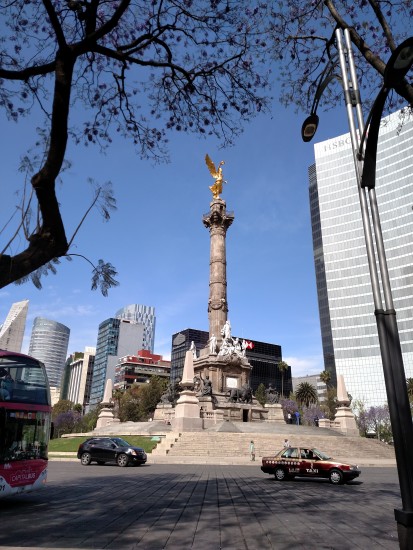
The Angel of Independence on Paseo de Reforma – Photo: (c) 2016 – Justin Crawford – All Right Reserved
The city is not on a usable grid as the grid tends to change as you cross neighborhoods. Main roads in the downtown area are:
- Paseo de la Reforma – Monumental Road connecting Chapultepec Park and the Zocalo. Lots of interesting monuments along the road including the Angel of Independence. Runs roughly southwest to northeast. Worth taking a walk down the road as it is really impressive.
- Avenida de los Insurgentes – The main road for the entire city. Runs roughly north to south.
- Avenida Chapultepec – Another main road downtown. Runs roughly east to west.
If you get lost, walk until you get to one of these roads.
Shopping
I don’t do much shopping, but two things of interest that I found in Mexico City that are both inexpensive and traditional Mexican items are silver jewelery and tequila.
- Silver jewelry can be bought from reputable stores along Avenida Francisco Madero near the Zocalo along the walking street. Prices should get more reasonable the better your Spanish is and the deeper you go into the maze of shops. Look for the “Sterling” or “925” mark on the silver to make sure you aren’t getting ripped off, and never buy silver off the street because you are probably getting ripped off. Generally, if you’re buying the silver from a store on the main drag (however far back and sketchy it is), you’re probably fine, and the saleswoman will probably show you the mark herself without even asking.
- Tequila can be bought at any grocery store. Generally, for anything expensive you’ll take a ticket to the counter and pay and they will get it out of the back for you. A bottle of the most expensive tequila I could find at the store was about $900, and it was excellent. Mezcal is also available and inexpensive, but it is not a traditional drink of Mexico City, and therefore slightly harder to find.
Money
- American Express is accepted at most decent-sized restaurants and stores, and nearly everywhere in the Centro Historico. If it is accepted, usually it’s clearly noted on the front window.
- You’ll want to have cash on you at all times for taxis, street food, craft markets, etc. Anywhere that isn’t a large storefront isn’t going to take a card. I planned on taking about $350 with me per day, and it was more than enough. Smaller bills (under $200) are better.
- ATMs are plentiful with many foreign and domestic banks (HSBC, Scotiabank, Santander, Banamex, etc.). ATMs will charge a fee of about $30 to withdraw money, and only pesos are available. If you have Bank of America, you can use any Santander ATM without any foreign ATM fees (the $30 above), but you will be charged a currency conversion fee, usually less than USD$1.
- You will need to have chips in any and all credit cards you use, including for the ATM.
Food and Drink
The food in Mexico City is amazing. From gourmet (relatively) expensive restaurants to the incredible amount and quality of cheap street food, you’re going to want to plan to eat a lot.
- Food and water safety is important in Mexico City. Everyone has heard of “Montezuma’s Revenge,” but the reality is that you’ll probably be fine or maybe have just a mild stomach ache so long as you’re not chugging tap water or being overly adventurous eating food on the street (e.g., eating at the street sushi stands—yes, they exist).
- The street food scene in Mexico City is extensive. Almost every corner has a few people cooking up street food, and it is very cheap. Tacos, Mexico City-style quesadillas, tlacoyos, Mexican tortas, tamales, and of course elotes/esquites are available on the street all over the city. You can even get breakfast on the street as people sell pastries (panes dulces) and coffee/hot chocolate in the morning on weekdays. Note that the coffee usually comes with a lot of sugar whether you like it or not. Prices are very cheap, averaging about $30 for something larger like a torta or $20 for five tacos.
- I prefer to eat on the street, but the restaurant scene is diverse and vibrant in Mexico City. One one end, there is the 24-hour diner-type place such as Casa de Toño where you can get some great after-bar snacks and excellent pozole. On the other end, some of the best restaurants in the world are also in Mexico City such as Contramar in Condesa. Even at the most expensive places, you’re only looking at about a $500/person check for an appetizer, entree, drinks, and dessert, so live it up a little bit.
Strange as it may seem for how inland it is, seafood restaurants in Mexico City are both plentiful and very good.
- Beer and tequila are the drinks of choice in Mexico City, although anything you want is usually available at most places. The beer in Mexico City is darker than what most might expect from the Mexican beer that you usually see in the United States (Corona or Modelo). The two main beers are Indio and Victoria, and both are similar to a Yuengling, Fat Tire, or Dos Equis Amber. There is very little draught beer available, and not much in the way of craft beers (I did see some on a few menus but all of the restaurants were mysteriously “out” of the craft beers). The tequila selection is as varied as you might imagine, and very inexpensive. Tequila bottle service in a decent bar in a nice neighborhood with unlimited soft drinks runs about $700.
There is also a drink called pulque, which is made from fermented maguey agave sap. It is usually mixed with some sort of fruit juice or puree to cut the yeasty flavor. Despite how weird it sounds, it’s actually pretty good—sort of like drinking an alcoholic smoothie—and although it is only about 5% ABV, it is sold in large quantities that go down easy.
Sunday
- Little to nothing is open in Mexico City after 6PM on Sundays. Sundays are traditional days for staying in with your family, so most stores and restaurants are closed. Be prepared to have a hard time finding a place to have dinner, and if you do, expect to be one of the only tables in the restaurant.
- There seem to be more restaurants, bars, and shops open in Condesa than anywhere else on Sunday. I’m not sure why, but that’s what I’ve experienced.
- All public parks and museums (including Teotihuacan, Chapultepec Castle, Templo Mayor, etc.) are free to Mexican citizens on Sundays, so they are very crowded on that day. It’s probably best to avoid those places if you can and opt for something that is private and for-profit (like Xochimilco). The upside is that no one asks for ID to prove citizenship, so if you Spanish is good enough and you act like you own the place, you might get in for free as I have before at the Templo Mayor.
The Sights
Just one piece of advice for any of these places: go early. Mexico City is a crowded place, and many of these places get uncomfortably crowded after noon. Force yourself to get to these places by 10AM, and you’ll get the best experience. Our driver very nearly forced us to get up and out early for his benefit and ours, and I couldn’t have been happier.
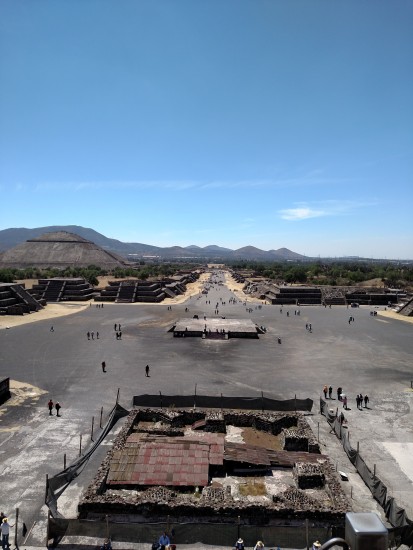
The Angel of Teotihuacan and the Pyramid of the Sun – Photo: (c) 2016 – Justin Crawford – All Right Reserved
- Teotihuacan – An ancient city with three massive pyramids about an hour north of the city. You can climb to the top of the pyramids for some really cool views. The Pyramid of the Sun is the third-largest pyramid in the world, and you can climb to the top. This is a must-see attraction. Get a private driver (see above) to drive you to the site. Bring sunscreen—we found out the hard way why they call it the Pyramid of the Sun when we got home and were all torched. Take your time with the climb to the top—Mexico City is at 7,500 feet above sea level, and you will get winded. Tickets were about $65 each, plus a parking pass for our driver to wait for us, which was about $40.
There are many restaurants that ring the site on the access road (you will need to be driven), all are tourist traps, but most are pretty good. I recommend La Gruta near Puerta 5 because who doesn’t want to eat in a giant natural cave?
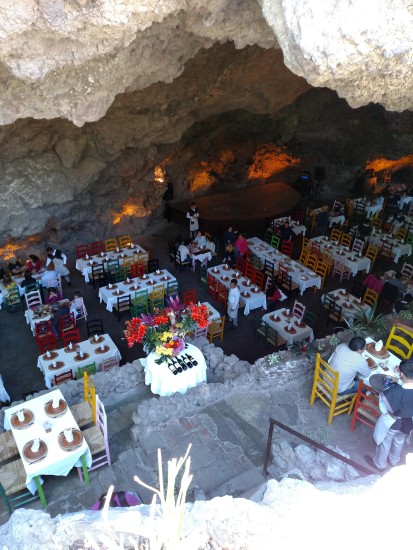
La Gruta Restaurant – Photo: (c) 2016 – Justin Crawford – All Right Reserved
Most drivers or guides will suggest a stop at the Basílica de Nuestra Señora de Guadalupe on the way back since they are on the same (north) side of town.
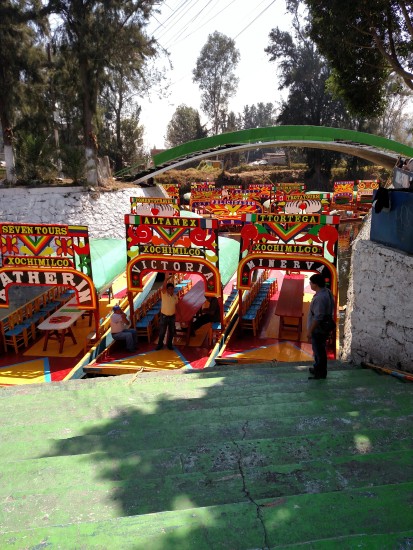
Boats at Xochimilco – Photo: (c) 2016 – Justin Crawford – All Right Reserved
Boats at Xochimilco (c) 2016 Justin Crawford – All Rights Reserved
- Xochimilco – Some of the last remnants of the lakes and Aztec canal systems that used to cover most of the area that is now Mexico City. There are Venice-style boats that you (and usually about a dozen of your closest friends) can be pushed around on through the canals. A great place to relax and take in the sights and have a few drinks while you float down the water. Ask the boat driver to take you down some of the side canals where it is really peaceful if you get tired of the “fiesta” on the main waterways. On the main waterways, people selling food, drinks, beer, live music, flowers, and just about anything you could want will pull up to your boat in their boats. Deep in the nature reserve part is the “Isla de las Muñecas” (Island of the Dolls), which is a major attraction, but be aware that it is a 6-hour round-trip boat ride. Prices should be a few hundred pesos each for the boat, and are very negotiable beforehand. Located on the very southern end of the city, it is about a 45-minute drive from the Centro Historico, and you can also get there by Metro to Light Rail. This is a good Sunday adventure as it is not free to Mexicans on Sundays, but it will still be crowded on any weekend day.
- Zocalo – The main city square in Mexico City with a giant Mexican flag, the Metropolitan Cathedral, Templo Mayor and the Palacio Nacional:
- Metropolitan Cathedral – Free to enter and take pictures, but it is a working church, so there may be services or weddings taking place while you are in there, so be respectful. Guided tours are available, and will take you up through the cathedral to the roof, which has a great view. Tours are at the small door at the top of the steps to the right of the main door (you’ll see people streaming in most likely), and while technically “free,” a small donation ($10 or so) is expected.
- Templo Mayor – The main Aztec temple ruins from the city before the Spanish arrived. The main square and cathedral were built upon the temple grounds. The entrance is to the right and behind the cathedral. Most of the temple was completely destroyed, so there isn’t a ton to see, but it’s pretty cool. Tickets are $57 and include admission to the museum (which I did not go into).
- Palacio Nacional – The main government building (the big building with the guards) to the right of the cathedral. While we wanted to go here to see the apparently beautiful Diego Rivera murals inside, we got there late (closes at 5PM), and also couldn’t find the public entrance. A policeman told us that the entrance is on the far left side (when facing the building from the Zocalo).
- Palacio de Bellas Artes – The main art museum and performance center for the city and country. Think The Met meets Kennedy Center. Occasionally, performances from inside are shown outside on a screen for free. A really beautiful building from the outside.
- Alameda Central – The old central park for the city. A nice place to relax for a bit. There is a pretty big market just to the west of the park that is a good place to pick up souvenirs and a snack.
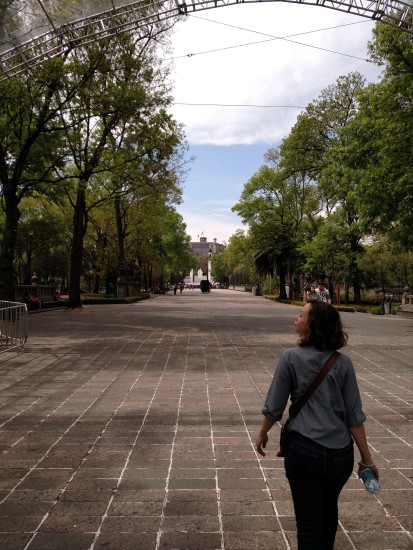
Chapultepec Park and Castle – Photo: (c) 2016 – Justin Crawford – All Right Reserved
- Bosque De Chapultepec – One of the largest city parks in the world and home to the only royal residence in North America that was occupied full-time by a royal family—Chapultepec Castle. The park is enormous, and has lakes, monuments, trails, etc. Check out the Voladores de Papantla in the northern part of the park near the Museo Nacional de Antropologí The castle is on a hill in the center of the park and is now half a National Museum and half a historic palace as it was when the emperor lived there. There are several famous murals and painted ceilings by Siqueiros and Flores. Entrance to the park is free; the museum is $65.
- Coyoacán – An old and beautiful neighborhood in the center-south of the city. About a 20-minute drive from downtown, and also has its own Metro stop. Used to be its own city until it was absorbed by Mexico City. Location of the Frida Kahlo and Diego Rivera museums and their old houses and haunts. A nice place to walk around in this very affluent neighborhood. Museum costs (depending if you buy tickets to both or not) approximately $140. A nice stop on the way back downtown from Xochimilco.
- Lucha Libre at Arena Mexico – My favorite thing to do in Mexico City. Just about every Friday night is the main CMLL Lucha Libre (Mexican professional wrestling) event that is recorded for TV (think Monday Night Raw). It is located at the historic Arena Mexico (not to be confused with the Arena de la Ciudad de Mexico) in the Doctores neighborhood, which is walkable from anywhere downtown or accessible by Cuauhtemoc Metro station a few blocks away. Tickets are available online via Ticketmaster, but you can get a better deal if you either buy them off the street in front or at the box office in person. The tickets for seats in the first ten rows are about $350, and the full fight card usually lasts about 3 hours. Bring cash for tickets, snacks, and beers. I cannot overestimate how fun this is.
About the Author
Justin Crawford travels when he can fit it into an otherwise busy schedule as an ice hockey referee in addition to a full-time job. He usually flies economy with his wife Michelle, and prefers short trips to big cities to long vacations at the beach. Feel free to follow him on Twitter or Facebook.
=====
To make sure you receive our latest deals, LIKE our The Flight Deal Facebook Page, follow us on Twitter @TheFlightDeal, Threads @TheFlightDeal or The Flight Deal WhatsApp channel or subscribe to The Flight Deal RSS Feed or Subscribe via Email (Once a Day)
The Flight Deal does not sell travel products or services. We provide you with information about third-party travel suppliers’ offers, and link you to their sites. The information posted by The Flight Deal is valid at the time of publication. However, we have no control over the suppliers, and we therefore do not warrant or guarantee that their offers will not change or become unavailable. Nor are we responsible for their products, services or site content. Please see their sites for their most up-to-date offer information and all applicable terms and conditions.
Sign up to receive The Flight Deal Daily DealsLetter, to stay up to date with the latest and greatest flight deals available.

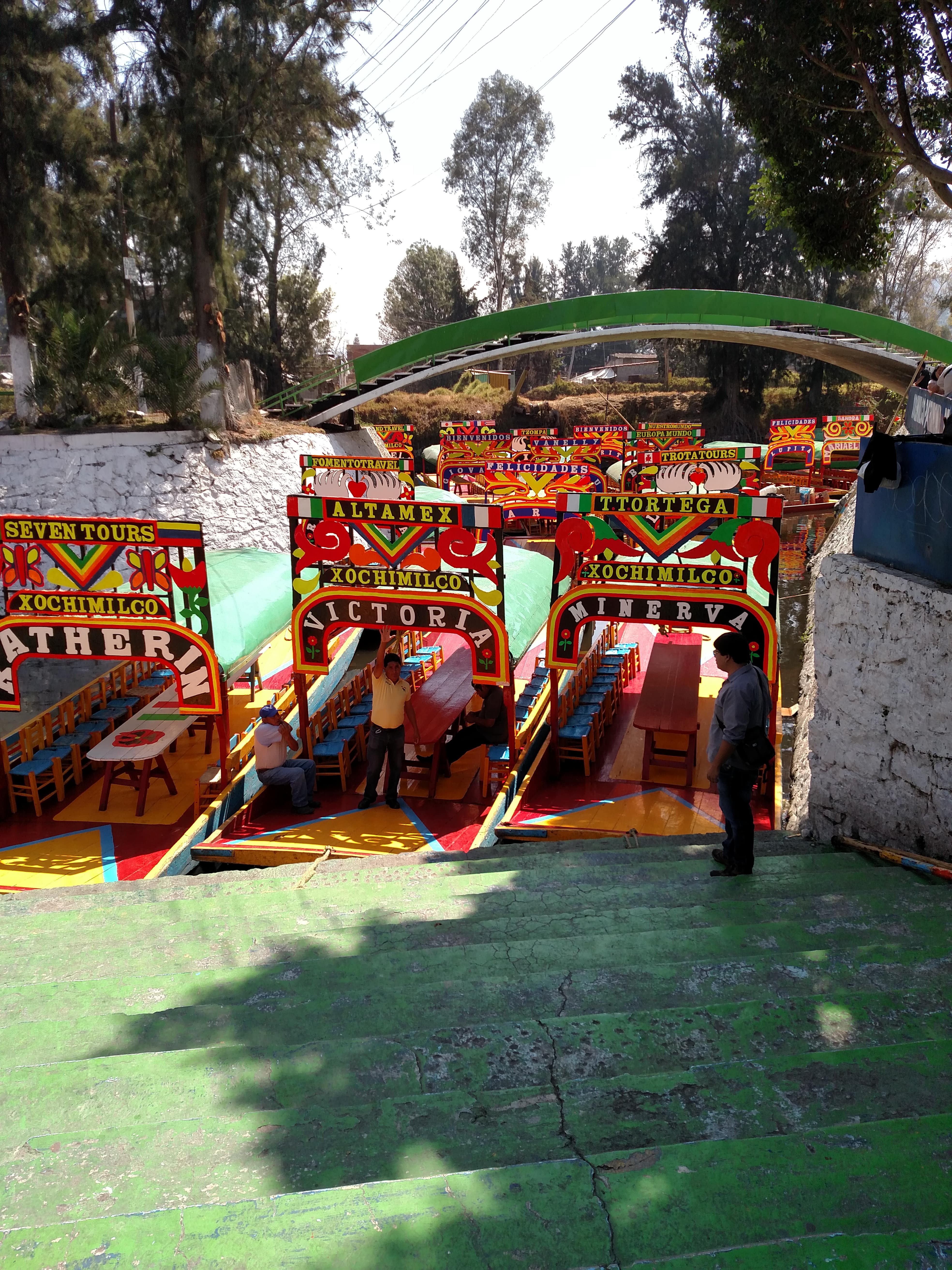

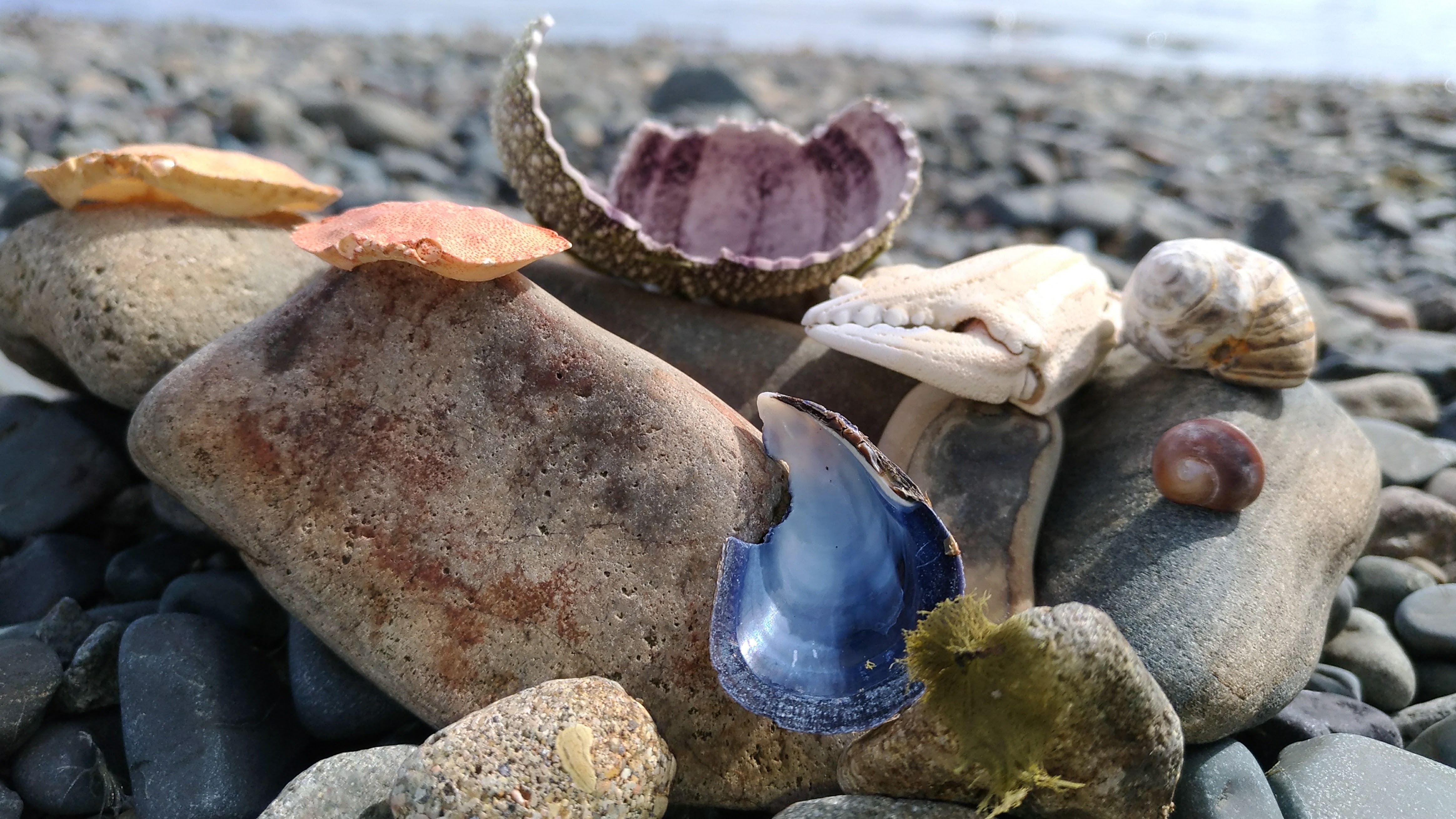
Thanks for the info. Great read. Will come in handy for my trip there.
KD
Great Info! Thanks for taking the time to share!
Please know there is a difference between direct and nonstop flights. You’re obviously referring to nonstop flights in this fine article,but a direct flight makes 1 or more stops. That’s the difference between nonstop and direct.
That was great! Can you write more city guides?